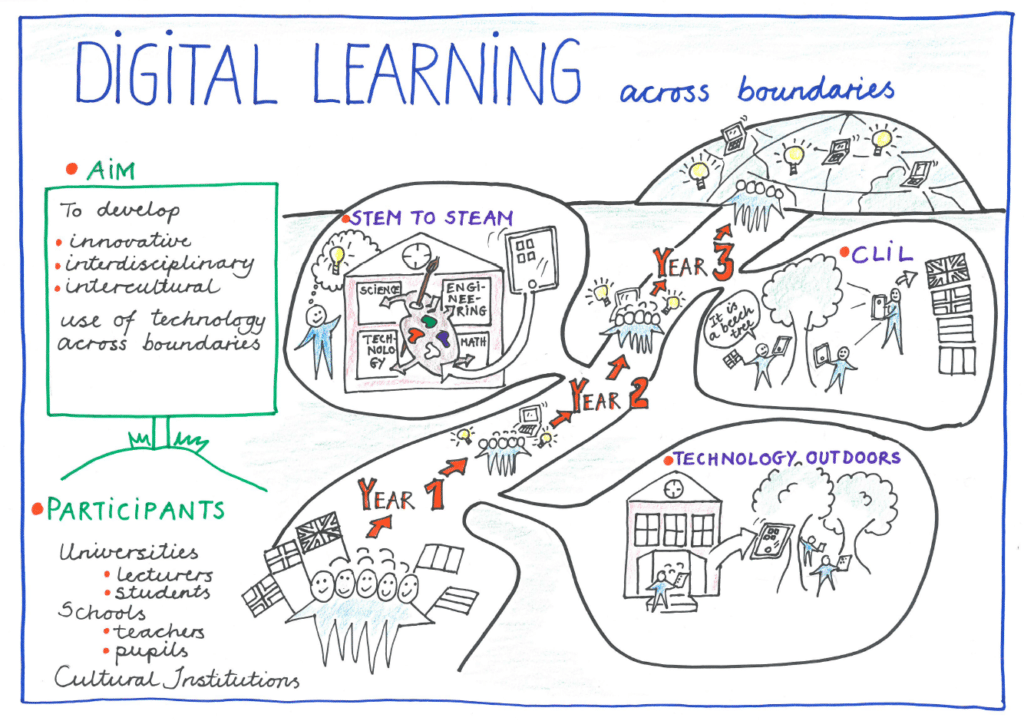A review of research literature on innovation and digital technologies highlighted a number of emerging technologies and pedagogical approaches with potential to impact on educational practice.
We have drawn three project themes to explore from these over the course of the three-year project.
Within each year are further sub-themes.
Extending learning beyond traditional classroom spaces and combining children’s digital and physical exploration of the world.
Supporting learners with disadvantaged backgrounds by managing transitions positively through collaborative outdoor learning experiences.
The sub-themes for year 1 are:
Each of these topics is covered within the Technology Outdoors online course which you can undertake at any time!
There’s also the below Google+ community where you can share ideas and talk to all members of the community:
What is STEM to STEAM?
STEM to STEAM concerns adding the Arts to the integrated and applied study of Science, Technology, Engineering and Maths (STEM), creating inter-disciplinary challenge-based online learning resources.
Why STEAM?
STEAM is a way of bridging the conventionally-held disconnect between the science and arts and leveraging on the principles of arts to maximise the output from STEM learning.
Creativity, wonder and imagination, which lie at the heart of the arts, blended with the critical thought and enquiry of STEM.
It allows students to connect their learning in these critical areas together with arts practices, elements, design principles, and standards to provide the whole pallet of learning at their disposal.
Further details
Please see the Google Slide deck – How can STEAM education help children to become STEAM literate
CLIL stands for Content and Language Integrated Learning and refers to teaching subjects such as science, history and geography to students through a foreign language.
To build on the previous years focusing on Technology Outdoors and STEAM, the DLaB CLIL 3rd year focuses on active learning using the environment, integrating subjects and embedding technology.
It aims to use curriculum contexts to teach language competencies and cultural sensitivity with the aim of meeting the language needs of a diversity of learners, including learners for whom English is an additional language (EAL/EFL).
CLIL will do this by establishing a Technology Enabled language learning approach for EAL and EFL learners, supporting learners with disadvantaged backgrounds (such as refugees, asylum seekers and migrants) and promoting intercultural understandings.
Our project partners already have experience in using CLIL to good effect and have seen great results from using CLIL within their own educational institutions – “Our pupils have improved their language skills in a way that gives them a more varied vocabulary. One of our goals using CLIL was to expand the English skills of our pupils – and we have succeeded.”
DLaB CLIL Keywords:
pluralinguisim, whole communication, creative language, gesture and drama, celebrating diversity, language and culture, scientific uses of language, common language roots, specific vocabulary and structures, authenticity of real world learning, genuine collaboration, real world STEM challenges
The progression of this project can be viewed from different perspectives:
- a) Over the course of three years, participants and stakeholders will investigate themes across subjects and cultures through adopting different viewpoints. Each year there will be a formative evaluation with the purpose of improving the project the following year. Summative evidence of the specific focus areas will be collected aiming at informing the international conference “Digital Learning Across Boundaries – Super Playdate” that will take part in the last year of the project as part of the dissemination.
- b) Each year the project will have a taxonomic progression building on the 21st century skills.
- c) Each year will involve a new group of trainee teachers and pupils who will obtain ICT competences and become part of a digital leaders programme in their institutions. This will gradually lead to the project being disseminated to a larger number of people across different educational levels.

